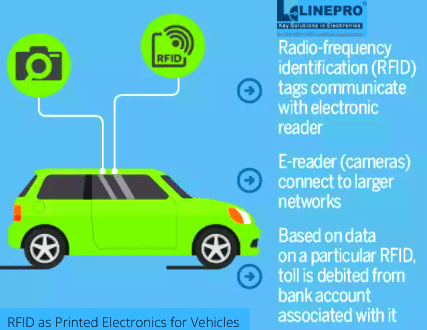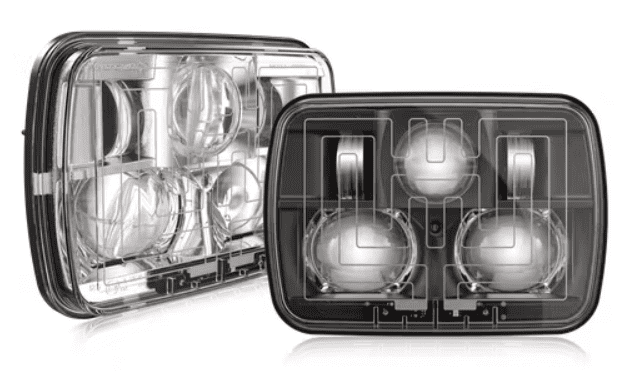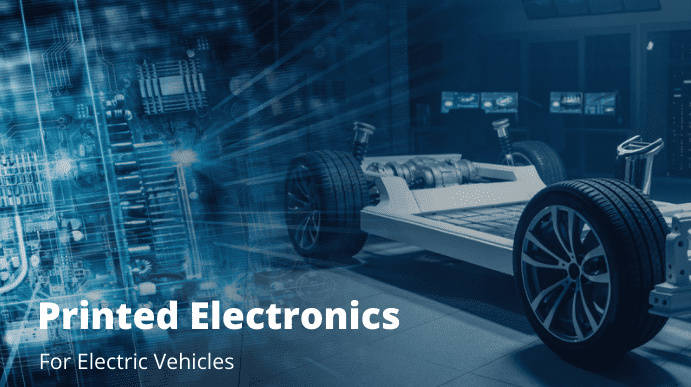Flexible Printed Electronics have greater opportunities than you think of for exteriors of cars for electric cars (EVs) particularly for things such as transparent heaters for sensors as well as integrated antennas that allow vehicle connectivity.

The reduction of weight is one of the primary goals of electric vehicles (EV) and it’s the same when we move to the more mainstream consumer electric vehicles. The advantages of using printed/flexible electronics to reach this objective of weight reduction on the exterior of vehicles as well as the incorporation of heaters with transparent surfaces to solar panels, which result from characteristics that include transparency, conformity, low weight and adjustable absorption of spectra. Printed Electronics in the form of printed heaters is widely used for aerospace application along with automotive applications due to it’s low power consumption.
Printed Heater for Automobile Application
Cameras, as well as Light Detection and Ranging (LiDAR) used in vehicles that are autonomous as well as advanced driver assist systems (ADAS) always require an uninterrupted perspective of traffic. This means that ensuring an opaque cover over the sensor that is free of frost or mist is crucial. Although it is a simple requirement, it is much more difficult to achieve for electric vehicles since there is less heat that is generated in a combustion engine that is conventionally used. The same argument is applicable to LED headlights as they’re much better than conventional halogen bulbs, but not enough to melt down ice accumulated on headlights due to minimal excessive or waste heat.

Printed traces on headlights of heavy vehicles like trucks
The answer to this problem is to create heaters that are transparent. This is possible by embedding printed wires using in-mold electronics (IME) or using conductors that are transparent, such as silver nanowires, carbon nanotubes (CNTs) or metal mesh. In time, these technologies will lower in cost, allowing the use of these technologies on windows too and making the task of scraping off ice from car windows no longer a necessity.
Connected cars need integrated antennas
With vehicles being connected, it is necessary to have several antennas to cover a variety of frequency bands. One solution is to put the antennas in plastic body panels. This can be done using in-mold electronic components or printing directly onto 3D materials.
Another non-metallic part of vehicles that could be used as antennas is windows. This would necessitate transparent conductors. The possible materials for transparent conductors and all of them are printed with silver nanowires, carbon nanotubes, fine metal mesh as well as very thin layers of ink that is free of particles.
Hybrid Short-Wave Infrared Sensors (SWIR) for ADAS
ADAS as well as autonomous cars will need a constant stream of data concerning their surroundings. This information is likely to be derived from multiple sources like LiDAR and cameras in order to boost redundancies, a process called sensor fusion.
This need for a wide range of sensors presents an opportunity to develop hybrid short-wave-infra-red (SWIR) sensors that need an insulating layer of printed semiconductor material over the CMOS reader circuit. The printed layer could be organic semiconductors as well as quantum dots with an intention to extend the sensitivity of spectral signals beyond silicon’s sensitivity into the SWIR region.
The imaging in the SWIR spectrum (1000-2000 millimeters) is particularly desirable for vehicles as light scatters less when it is at the longer wavelength, allowing objects to be recognized over longer distances when in dust or fog. The current technologies to create SWIR imaging sensors are extremely expensive, which is why cutting-edge technologies like hybrid partially printed sensors are needed.
Enhancing battery life by using thin-film photovoltaics
While photovoltaics may not be in a position to power a car continuously for long distances but they can allow for about 30km of distance to be added daily. This eliminates the requirement to recharge vehicles that are used only for short journeys within cities, greatly improving the convenience. In addition integrated photovoltaic panels can be used to power ancillary equipment like air conditioning while the vehicle is not using the batteries.
Few electric vehicles that incorporate solar panels make use of silicon photovoltaics because it’s the standard technology that has been proven to have endurance. However, newer photovoltaics on thin films such as those made of organic semiconductors and even perovskite are promising options due to their lightweight and their conformity. This is crucial in the event that solar panels ever be used to cover the entire exterior of the car, because unlike flat silicon panels that are rigid they would not have the requirement to sacrifice style or aerodynamics.
Displays of the exterior for autonomous vehicles
As the degree of car autonomy grows, it will be required to communicate with pedestrians. If your car is driven by computer software, you do not have the “assurance” of visual signals that you would get if there were someone driving in order to ensure that they’ve seen you prior to walking into the path of a vehicle that is moving slowly. One solution to this problem is to put a huge display on the car’s bonnet that displays information like whether it is safe to step in front.
Printing and flexible displays that are low-cost are ideal for this because their weight, durability and conformity (including in an accident) are more important than resolution. The possibilities include printed LEDs and mounting LEDs onto flexible substrates.
Electronics Printed/Flexible in Electric Vehicle Powertrains
When you look at the other components of the vehicle, there are plenty of opportunities for electric vehicle powertrains as well as the interiors of vehicles.
Regarding powertrain section, one of the areas is monitoring the battery and heating for electric vehicles. Giving the best range with a given weight and cost is an essential need for electric vehicle manufacturers. The batteries must always perform as efficiently as they can. However, the capacity of batteries is highly dependent on the temperature. Additionally, an increase in temperatures (and pressure) could signal a malfunction and may pose a safety concern. Therefore, there is a chance to print a variety of temperature sensors to offer local monitoring and heated elements to be incorporated into the same film that functions.
Another potential application for powertrains is material for thermal interface used in EVs. While printed electronics aren’t ideal for power electronics, they need printed materials for thermal interfacing to aid in thermal management. The use of thermal greases is still the standard, but alternative materials such as carbon nanotubes or material that change phase are certain to gain momentum. As electric vehicles shift to higher rates of charging and higher speeds, the requirement for thermal management becomes more crucial.
Flexible electronics printed on the inside of cars
Interiors of vehicles have been the main issue for flexible and printed electronic. Some of the areas covered by printed electronics include the interface between humans and machines as well as interior heaters, lighting and displays.
Human Machine Interface (HMI) technologies
Human Machine Interface (HMI) technologies are a huge possibility for printed or flexible electronics. HMIs that are designed for the interior are used extensively in occupancy sensors for seats, printed pressure sensors are expected to make their way into control panels that offer an array of inputs as compared to capacitive touch sensors, without expending on mechanical switch. In addition occupancy sensors are expected to develop into multipoint sensors spread throughout the fabric of seats to track the level of comfort for passengers.
Printed and Flexible Interior Heaters
The current method of heating conventional car interiors using hot air to blow around is inefficient and extremely detrimental to the electric vehicles. The use of printed flexible electronics to include heaters at touch points is more effective – this method will likely extend beyond steering wheels and seats to include armrests as well as center consoles. In addition, the conformity of printed electronics allows heaters to be placed nearer to their surface which makes heating more effective and flexible. Conductors with transparent surfaces also known as transparent heaters take this concept further and can be directly applied to the surface of objects like leather.
Interior lighting and displays
Manufacturers are increasingly looking to differentiate their vehicles by having several displays. These display options go beyond the standard center screen, and can feature digital gauge clusters as well with mirror-inspired displays and entertainment for the passengers. Organic Light Emitting Diodes OLEDs are expected to become more popular, since their resolution and color range match the expectations that consumers transmit through their phones. Conformity will also allow more possibilities for integration, like the safety-enhancing ‘transparent’ pillars. Interior lighting that is distinct also provides LEDs, which are mounted on flexible substrates, an emerging lightweight and flexible approach.
In short, three main technological shifts will lead to these possibilities for printed and flexible electronic devices in the automotive industry. One of them is the increasing use of EVs as well as the increase in autonomy that will increase the amount of sensors needed as well as the transition from the powertrain to cockpit, to allow the differentiation of automobile manufacturers.
Linepro has widely worked with Electric Vehicle Manufacturers for input devices like keypads and printed and transparent heaters. We believe in contributing to ever-innovative electric vehicle industry in every way possible. We are always ready to take up challenging projects related to electric vehicles. Share your project details and we start guiding you!


